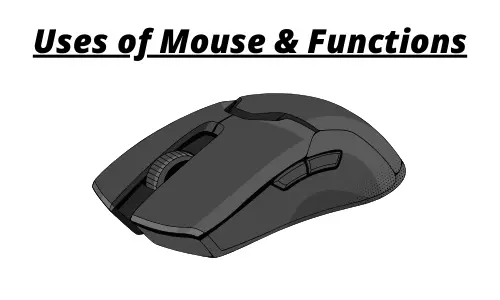Hello Learners, Today we will learn the uses of Mouse and the Functions of Mouse.
This Article is the Best on the whole internet.
I guarantee you, after reading this article you will not need to read any other Articles. In fact, our readers are satisfied with this blog post.
Note – The only purpose of this article is to tell you about the different uses of computer Mouse in very simple language. This article has been written by an expert person. If you think this article can be improved further then, you must give us feedback.
What is Computer Mouse?
A computer mouse is an input device to be held in hand and used to interact with a computer. This device commonly comes with two buttons and a scroll wheel that, when moved, enables one to move the cursor on the screen, select items, click items to open or perform functions, drag objects across the screen, and scroll through pages of documents.
What are the Uses of Mouse in Computer?
There are 10 common uses of the mouse in our computer system, which are given below.

- Pointing and Clicking - Placing the cursor/mouse on an object on the screen and pressing down on a mouse button to highlight, open, etc.
- Scrolling - The action of moving up and down through documents, web pages, or lists, using the mouse wheel to push the document up or down on the screen.
- Drag-and-Drop - The action of clicking and holding on an object in one position and moving the cursor to another location and releasing the button; the object thus "drops" to the new position.
- Text Selection – Click and drag over text to highlight it for copying, cutting, or formatting.
- Context Menus – Right-click to gain context-specific menus with more options and actions.
- Gaming – The mouse allows accurate control and movement while playing computer games, often fitted with extra buttons to perform game-specific actions.
- Graphic Design and Digital Art - Drawing, designing, and moving graphics with mere exactness by mouse, especially in applications software like Adobe Photoshop or Illustrator.
- Software Management - Performing software applications by touching icons, menus, and buttons of two or more software.
- Window Resizing - By clicking and dragging along the edge or corner of a window using the mouse, drag make it bigger or smaller.
- Zoom In/ Out - Most mice have specific functions when we scroll and hold down a particular key.
Components & Functions of Mouse
An important function of a computer mouse is to move the cursor from place to place, open an icon, close or open an application, select a folder, a text file, or drag-and-drop. All this work is done through the mouse in a computer.
Here are some key components and functions of a computer mouse:
- Buttons - A mouse will typically have at least two buttons: a left button and a right button. The left button selects objects among other uses, and the right button conventionally opens context menus.
- Scroll Wheel - This is between the buttons. It allows the user to scroll up and down through documents or Web pages.
- Sensor - Today's mouse uses an optical or laser sensor to detect movement. These sensors track mouse movements across a surface and translate that movement into the moving of the cursor on the screen.
- Connection - The mouse can either use a wired USB connection directly to the computer or be wireless via Bluetooth or through a USB receiver.
- Special Features - Some mice have additional buttons to do more sophisticated tasks, which would be either some customized settings, comfort-ensuring ergonomic designs, or highly precise functions suitable for gaming and graphic design.
Overall, The computer mouse is used for navigation and interaction with the GUI.
Why do I use a Mouse?
The mouse has many advantages over other pointing devices for a more relaxed and effective interaction style for the user. There are a number of reasons that make one use a mouse:
- Precision - A mouse is perfect for selecting text, clicking on icons that have very tiny sizes, and handling graphical elements that are too detailed.
- Ease of use - Pointing and clicking are very user-friendly ways for someone to use a computer, especially novices.
- Speed - The fastest screen navigation, file-opening, internet browsing, and carrying out other operations with relief is provided by it in a better way than what the keyboard can do.
- Usability - A mouse performs varied actions, like clicking, right-clicking, scrolling, dragging and dropping, and so many more that assist in making lots of applications on the computer productive.
- Ergonomics - Most mice are designed so that they can rest comfortably in your hands, making their use for long periods a lesser strain than, for example, a touchpad compared to other input tools.
- Better Navigating - Having a combination of buttons and a scroll wheel on a mouse is beneficial when trying to navigate through open documents in applications or web pages.
- Best for Specific Task - At times, specific work applications just need the accuracy and features that a mouse provides, like in graphic design, gaming, or editing when you have to control it specifically.
- Accessibility - For users with disabilities or who are movement-impaired, the following are mice and accessories that would offer a more accessible way to interact with a computer.
It is, overall, versatile, efficient, and user-friendly to enhance the computing experience by providing control with precision and ease of navigation.
Thanks for you lesson
Many thanks for your impact
God bless you in Jesus Name
Thanks, Alvin G. Blokar
Thanks you for your lesson
Thank you